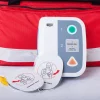Recent Post
- What Maintenance Is Required for an AED: Everything You Need To Know
November 14, 2025  Could You Recognise the Signs That Someone Needs a Defibrillator?
Could You Recognise the Signs That Someone Needs a Defibrillator?
September 12, 2023
An AED, or Automated External Defibrillator, can provide crucial support during a cardiac emergency and significantly improve the chances of a positive outcome. And like any piece of lifesaving equipment, it requires a bit of ongoing care. Undertaking regular maintenance and checks ensures your AED is always in working order and ready to do its job when every second counts. Not to mention, staying on top of maintenance helps you meet safety rules and legal requirements, while reducing the risk of unexpected failures when it matters most.
This may all sound a little intense, but don’t worry, in this article, we’ll break down everything you need to know. We’ll cover what type of maintenance is required for an AED, why and how often you should do it, and answer some of the most common questions along the way.
Why Should I Check My Defibrillator?
Regular defib maintenance checks aren’t just a good idea if you have some spare time; they are essential for safety purposes. Regular maintenance ensures the device will work when every second counts. Here are the key reasons why routine checks and upkeep are so important:
- Ensures Functionality: Simple checks confirm the AED is operational and ready to use.
- Prevents Expired Components: Batteries and electrode pads do not last forever, and expired parts can fail if not replaced.
- Regulatory Compliance: Many Australian workplaces and public spaces are required to meet specific requirements for defibrillator maintenance.
- Reduces Risk of Malfunction. Preventive care reduces the likelihood of device failure.
- Offers Peace of Mind: Knowing the AED is ready for an emergency provides peace of mind.
Regardless of where the AED is stored, following clear safety and maintenance procedures ensures it remains dependable in the event of an emergency.
What Maintenance Does a Defib Require? A Checklist
Use this AED maintenance checklist to ensure your defibrillator is always ready when you need it most.
Visual Inspection
- Examine the AED casing for visible damage, such as cracks, dents, or warping.
- Check the carrying case for dust, dirt, or moisture.
- Confirm all labels and instructions are clear and legible.
Indicator Lights
- Check the status indicator light or display, and make sure the device shows it is ready.
- An amber or red warning light usually means maintenance or replacement is needed.
- Follow the AED manual to determine the meaning of each indicator.
Battery Check
- Verify the battery charge level if the AED displays it.
- Confirm the battery expiration date has not passed.
- Replace batteries according to the manufacturer’s guidelines, or if the device signals low power.
Electrode Pads
- Check electrode pad expiration dates, and replace pads if expired.
- Replace pads immediately if their packaging is opened or damaged.
- Keep spare electrode pads on hand so the device is always ready.
Accessories
- Ensure accessories such as scissors, gloves, razors, and towels are present and in usable condition.
- Replace any consumables that have been used or expired.
Record Keeping
- Keep a detailed log of inspections, battery replacements, and pad changes.
- Record dates, findings, and any actions taken during each check.
- Good records help meet safety regulations and support ongoing maintenance schedules.
Priority First Aid offers AED maintenance support and replacement parts. We can help you meet compliance standards while keeping your defibrillator ready. Please don’t hesitate to contact us if you have any questions.
How to Store an AED
Proper storage is just as important as regular maintenance. Here are some practical tips to keep your AED ready for action:
- Store your AED in a visible and easily accessible location, so it can be reached quickly in an emergency.
- Avoid places with extreme heat, high moisture, or direct sunlight, as these conditions can damage the device and reduce its battery life.
- Use wall-mounted cabinets with clear signage to protect the AED and make it easy to spot.
- Run regular staff familiarisation sessions in workplaces or public spaces, so that people know where the AED is located and how to access it.
- Keep the AED in a clean, dry, clearly marked spot. Quick retrieval can save precious time when it matters most.
Frequently Asked Questions (FAQs)
If you have any questions about defibrillator maintenance checks, please explore our frequently asked questions below or refer to our Defibrillator Safety Guide. Otherwise, please contact our team, and we’ll be more than happy to help you.
How Often Should I Check My AED?
You should check your AED at least once a month. Carry out more comprehensive inspections every six months, or as the manufacturer recommends.
How Long Do AED Batteries and Pads Last?
Batteries typically last between two and five years, depending on the model. Electrode pads usually expire after about two years, although some brands have a longer expiration date. Always rely on the manufacturer’s guidance, and replace parts when their expiry dates pass.
Can I Perform Maintenance Myself, or Do I Need a Technician?
You can handle basic maintenance, such as visual checks, verifying batteries, and inspecting pads. However, for repairs or technical faults, call a certified technician. Don’t try to be a hero with complex fixes.
What Happens If the AED Fails a Self-Check?
If the AED fails its automated self-test, do not use it. Contact your maintenance provider or a technician immediately. Treat it like a broken smoke alarm. You wouldn’t ignore that.
Does Priority First Aid Offer AED Maintenance Services?
Yes. Priority First Aid provides professional AED maintenance, advice, and replacement supplies to keep your defibrillator compliant and ready for use.
Reach Out to Priority First Aid
Keeping your AED in working order is vital when every second counts. If you need help with maintenance, replacement pads, batteries, or expert guidance, contact Priority First Aid. We can help ensure your defibrillator is ready and reliable when needed most.




